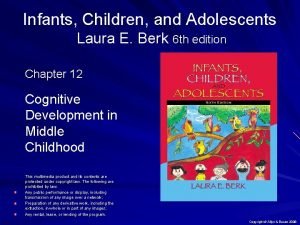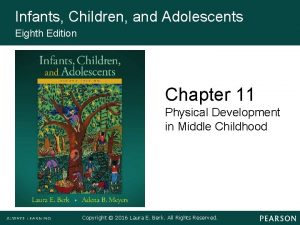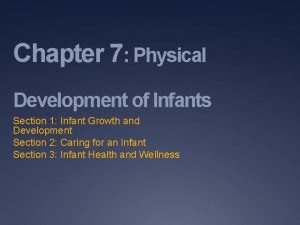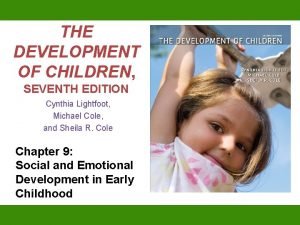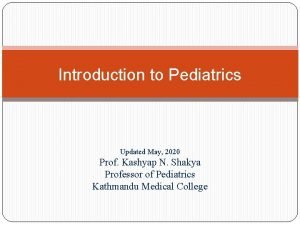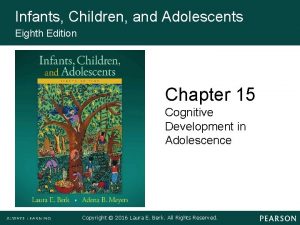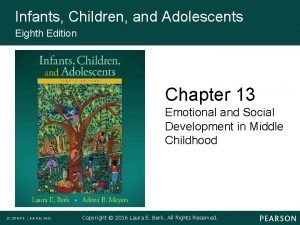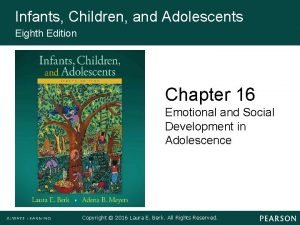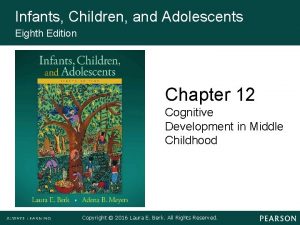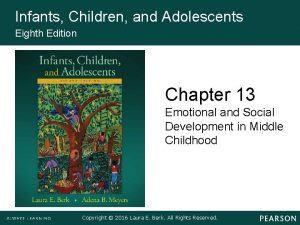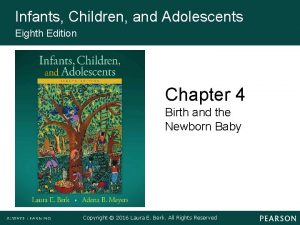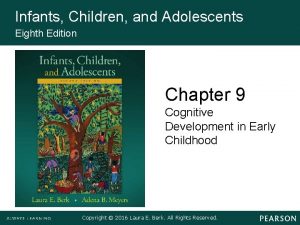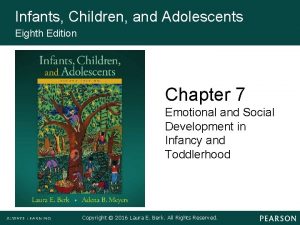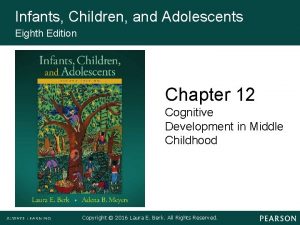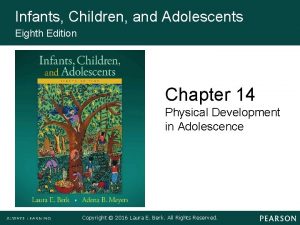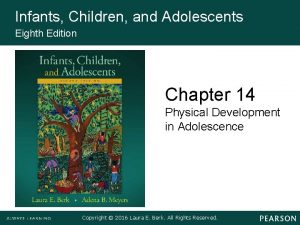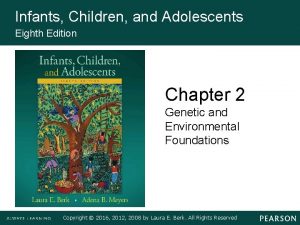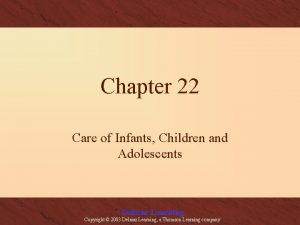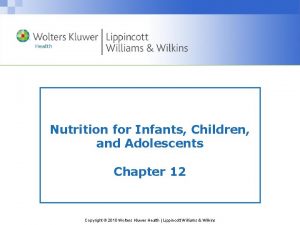Infants Children and Adolescents Eighth Edition Chapter 3


































- Slides: 34

Infants, Children, and Adolescents Eighth Edition Chapter 3 Prenatal Development Copyright © 2016 Laura E. Berk. All Rights Reserved

Learning Objectives (1 of 2) Prenatal Development • • • 1. How has decision making about childbearing changed over the past half century, and what are the consequences for child rearing and child development? 2. List the three phases of prenatal development, and describe the major milestones of each. 3. List agents known to be or suspected of being teratogens, and discuss evidence supporting their harmful impact. Copyright © 2016 Laura E. Berk. All Rights Reserved

Learning Objectives (2 of 2) • • 4. Describe the impact of other maternal factors on prenatal development and health care. 5. What factors contribute to preparation for parenthood during the prenatal period? Copyright © 2016 Laura E. Berk. All Rights Reserved

Why Have Children? In Western nations, having children is a matter of individual choice. 90% of U. S. adults have or plan to have children, depending on: • Financial circumstances • Career goals • Values • Health conditions Copyright © 2016 Laura E. Berk. All Rights Reserved

Why Have Children? (continued) Advantages: • Personal fulfillment • Being a responsible and mature adult • Caregiving and support in old age • Continuing the family name • Strengthening couple relationship Copyright © 2016 Laura E. Berk. All Rights Reserved

Why Have Children? (continued) Disadvantages: • Responsibility for child’s well-being • Role overload • Financial strain • Loss of privacy Copyright © 2016 Laura E. Berk. All Rights Reserved

How Large a Family? • Average number of children has declined in Western nations since 1960 – More effective birth control – Fewer children more compatible with women’s careers – Divorce • Low-SES mothers tend to have more children Copyright © 2016 Laura E. Berk. All Rights Reserved

American Mothers Getting Older Advantages: • More emotionally mature • Financial stability Disadvantages: • Declining reproductive capacity (female and male) • Increased risk of chromosomal and genetic disorders Copyright © 2016 Laura E. Berk. All Rights Reserved

American Women Bearing Children at Older Ages Figure 3. 1 (Based on U. S. Census Bureau, 2014 b. ) Copyright © 2016 Laura E. Berk. All Rights Reserved

Conception and Implantation Figure 3. 2 (From Before We Are Born, 6 th ed. , by K. L. Moore and T. V. N. Persaud, p. 87. Copyright © 2003, reprinted with permission from Elsevier, Inc. ) Copyright © 2016 Laura E. Berk. All Rights Reserved

Periods of Prenatal Development • Germinal • Embryonic • Fetal Copyright © 2016 Laura E. Berk. All Rights Reserved

Germinal Period • Weeks 1– 2 • Implantation of the blastocyst • Development of the – Amnion – Chorion – Placenta – Umbilical cord Copyright © 2016 Laura E. Berk. All Rights Reserved

The Placenta and Umbilical Cord Figure 3. 3 (From Before We Are Born, 6 th ed. , by K. L. Moore and T. V. N. Persaud, p. 95. Copyright © 2003, reprinted with permission from Elsevier, Inc. ) Copyright © 2016 Laura E. Berk. All Rights Reserved

Embryonic Period • Weeks 3– 8 • Central nervous system, internal organs, muscles, and skeleton begin to form. – Heart begins pumping blood. – Liver and spleen begin producing blood cells. – Neurons develop rapidly. • External features also form: eyes, ears, nose, limbs. • Testes in male begin producing testosterone Copyright © 2016 Laura E. Berk. All Rights Reserved

Fetal Period • Week 9 to the end of pregnancy • First trimester: – Organs, muscles, and nervous system organize. – External genitals are well-formed. • Second trimester: – Mother can feel movements. – Neurons form synapses at a rapid pace. – Sensitivity to sound and light emerges. Copyright © 2016 Laura E. Berk. All Rights Reserved

Fetal Period (continued) • Third trimester: – Fetus reaches age of viability (between 22 and 26 weeks). – Rapid gain in neural connectivity and organization continue. – Responsiveness to external stimulation increases. – Extensive body growth occurs. Copyright © 2016 Laura E. Berk. All Rights Reserved

Prenatal Environment and Later Health Low Birth Weight • Greater chance of – Heart Disease – Stroke – Diabetes High Birth Weight • Greater chance of – Breast cancer – Prostate and other cancers Copyright © 2016 Laura E. Berk. All Rights Reserved

Prenatal Environmental Influences: Teratogens Teratogen • Any environmental agent that causes damage during the prenatal period Effects depend on: • Dose • Heredity • Other negative influences • Age Copyright © 2016 Laura E. Berk. All Rights Reserved

Teratogens • Drugs – Prescription – Nonprescription – Illegal • Tobacco • Alcohol • Radiation • Pollution • Infectious disease Copyright © 2016 Laura E. Berk. All Rights Reserved

Drugs • Prescription and nonprescription – Isotretinoin: eye, ear, skull, brain, heart, and immune system abnormalities – Aspirin: possible low birth weight, infant death, poor motor development, lower intelligence – Caffeine: low birth weight – Antidepressants: premature delivery, birth complications, high blood pressure Copyright © 2016 Laura E. Berk. All Rights Reserved

Drugs (continued) • Illegal drugs – Cocaine, heroin, and methadone are all linked to a variety of severe problems. – Marijuana is associated with poor academic achievement, impulsivity, depression. – Lasting findings, however, are not well established. Copyright © 2016 Laura E. Berk. All Rights Reserved

Tobacco • 11% of U. S. women smoke while pregnant. • Can cause: – – – – Low birth weight Miscarriage Prematurity Cleft lip and palate Abnormal blood vessels Infant death Asthma and cancer later in childhood Copyright © 2016 Laura E. Berk. All Rights Reserved

Fetal Alcohol Spectrum Disorder: Criteria for Diagnosis DIAGNOSTIC CATEGORY Criteria FAS p-FAS ARND Slow physical growth Yes No No Facial abnormalities: All three are present • Short eyelid openings • Thin upper lip • Smooth or flattened philtrum Two of the three are present None are present Brain injury Impairment in a minimum of three areas of functioning Table 3. 3 Source: Mattson, Crocker, & Nguyen, 2012. Copyright © 2016 Laura E. Berk. All Rights Reserved

The Effects of Environmental Pollution • More than 75, 000 chemicals are in common use in the United States. • Many babies are “born polluted” – Diverse impairments in physical and mental development – Increased chances of life-threatening diseases and later health problems Copyright © 2016 Laura E. Berk. All Rights Reserved

Infectious Disease • Viruses – – Rubella Chickenpox HIV and AIDS Various herpes viruses • Bacteria and Parasites – Toxoplasmosis – Chlamydia and syphilis – Tuberculosis Copyright © 2016 Laura E. Berk. All Rights Reserved

Maternal Factors in Prenatal Development • Exercise • Nutrition • Emotional stress • Rh blood factor • Maternal age • Previous births Copyright © 2016 Laura E. Berk. All Rights Reserved

The Effects of Emotional Stress on the Developing Fetus • Stress hormones cross the placenta, causing a dramatic rise in fetal heart rate and activity. • Maternal emotional stress predicts anxiety, short attention span, anger, aggression, and overactivity among young children. • Stress-related prenatal complications can be greatly reduced when mothers receive support from family members and friends. Copyright © 2016 Laura E. Berk. All Rights Reserved

The Nurse–Family Partnership • Voluntary home visiting program for low-income, first-time mothers • Children having experienced the program show: – Higher language and intelligence scores – Fewer behavior problems • Mothers in the programs experience: – – Fewer subsequent births, greater birth spacing More contact with child’s father More stable intimate relationships Less welfare dependence Copyright © 2016 Laura E. Berk. All Rights Reserved

Prenatal/Birth Complications Increase with Maternal Age Figure 3. 6 (Based on Salihu et al. , 2003. ) Copyright © 2016 Laura E. Berk. All Rights Reserved

Iron Deficiency and Memory Impairments in Infants of Diabetic Mothers • Throughout pregnancy, mother’s volatile glucose levels can cause birth defects or abnormal fetal growth. • The fetus’s reaction to this extra glucose results in iron deficiency, which harms brain cell growth. • Resulting memory problems continue into the preschool years. Copyright © 2016 Laura E. Berk. All Rights Reserved

Expectant Mothers with Late or No Prenatal Care Figure 3. 7 (Based on Child Trends, 2014 b. ) Copyright © 2016 Laura E. Berk. All Rights Reserved

Reasons Women Delay Prenatal Care • Financial hardship • Situational barriers • Personal barriers • Many are reluctant to disclose high-risk behaviors Copyright © 2016 Laura E. Berk. All Rights Reserved

Culturally Sensitive Prenatal Care Promotes Healthy Pregnancies • Low-SES ethnic minority women often reported depersonalizing prenatal care. • Group prenatal care offers a sensitive alternative – group discussions about health issues in native language – led to more health-promoting behaviors and reduced low birth weight and prematurity Copyright © 2016 Laura E. Berk. All Rights Reserved

Preparing for Parenthood Expectant parents • get to know the baby as an individual. • look for models of effective parenthood. • adjust their relationship as a couple. Copyright © 2016 Laura E. Berk. All Rights Reserved
 Infants, children, and adolescents 8th edition
Infants, children, and adolescents 8th edition Lara berk
Lara berk Gains in perspective taking permit the transition to
Gains in perspective taking permit the transition to Infants and children 8th edition
Infants and children 8th edition Psychology eighth edition david g myers
Psychology eighth edition david g myers David g myers psychology 8th edition
David g myers psychology 8th edition Operations management eighth edition
Operations management eighth edition The fifth, sixth, seventh, and eighth amendments protect *
The fifth, sixth, seventh, and eighth amendments protect * What is the difference between courting and dating
What is the difference between courting and dating Intellectual development of infants chapter 9
Intellectual development of infants chapter 9 Chapter 7 physical development of infants
Chapter 7 physical development of infants Anagram of eighth
Anagram of eighth Matching planet rings
Matching planet rings Nearest eighth of an inch
Nearest eighth of an inch Eighth commandment catholic
Eighth commandment catholic Taj mahal 8th wonder of the world
Taj mahal 8th wonder of the world Arterier og vener
Arterier og vener Eighth amendment excessive bail
Eighth amendment excessive bail Eighth letter of the alphabet
Eighth letter of the alphabet Criminal justice lesson
Criminal justice lesson What's the 5th amendment
What's the 5th amendment Exceptional children 10th edition
Exceptional children 10th edition Cynthia lightfoot
Cynthia lightfoot The development of children 7th edition
The development of children 7th edition Exceptional children an introduction to special education
Exceptional children an introduction to special education Exceptional children 10th edition
Exceptional children 10th edition Mis chapter 6
Mis chapter 6 Chapter 1
Chapter 1 Creative curriculum for infants and toddlers
Creative curriculum for infants and toddlers Subcostal retractions
Subcostal retractions Infants age range
Infants age range Give me a dozen healthy infants well-formed meaning
Give me a dozen healthy infants well-formed meaning Strickler spine and sport
Strickler spine and sport Art ideas junior infants
Art ideas junior infants Personality development in infancy
Personality development in infancy

